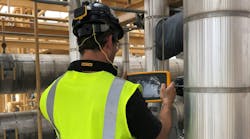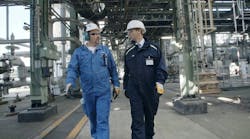A submersible mixer is helping a supplier of process and wastewater treatment technologies, World Water Works, implement a side-stream de-ammonification process that removes nitrogen from wastewaters containing ammonia concentrations greater than 200 mg/L — according to sources, a first in North America.
Great Britain-based Landia is a maker of chopper pumps, submersible mixers, jet aerators and other process units. The Landia mixer agitates, homogenizes and suspends solids in demanding conditions. At the York River treatment plant in Seaford on Virginia’s coastline it is used to mix granulated sludge for World Water Works’ "Demon" process.
Oklahoma City, Oklahoma-based World Water Works (WWW) teamed with regional wastewater treatment utility HRSD in a private-public partnership to successfully install the centrifuge centrate treatment process — used previously only in Europe.
"High concentrations of ammonia in effluent present a continuing problem for municipal wastewater plants and many industrial facilities," says World Water Works’ Daniel Dair.
Getting rid of ammonia
De-ammonification, which is partial nitritation by ammonia-oxidizing bacteria (AOB) combined with anaerobic ammonium oxidation (anammox), provides up to 70-90 percent total nitrogen removal. It also sees a 50 percent reduction in alkalinity requirements (compared to traditional nitrification-denitrification), a 65 percent reduction in aeration energy, and a 100 percent reduction in supplemental carbon.
The application is one of several available forms of single-step — i.e., in the same tank — partial nitritation-anammox designed for centrate treatment from anaerobically digested Bio solids and operated as a sequencing batch reactor.
Unlike conventional and typically costly denitrification methods, which require large amounts of energy and methanol, the centrifuge centrate treatment processes AOB and anammox efficiently and removes ammonia from wastewater. It uses 60 percent less energy and eliminates need for methanol. It also produces 90 percent less sludge than conventional systems. Besides reducing costs, the process sequesters carbon dioxide for a low carbon footprint. System resilience lessens the need for oversight and maintenance.
Developed and patented by the University of Innsbruck in Austria, the "Demon" process is already employed at around 40 European plants, but because of requirement for seeding the process with imported biomass from European operating facilities, there had been no full-scale application elsewhere. Given energy and carbon savings, significant interest exists elsewhere.
The plant was also the site of another first. The York River treatment plant included a fully aerobic nitrifying activated sludge system with post denitrification filters. Elements of that system were used to assemble the new solution.
Significant side notes
In 2002, HRSD launched Virginia’s first municipal water reuse project at Seaford, which required the construction of a sequencing batch reactor. However, the initiative ended when its only customer, an adjacent refinery, closed.
Subsequently, during recent plant upgrades, the sequencing batch reactor and equalization tanks from the reuse project were retrofitted to serve for centrate equalization and full nitrification. This meant that only minor piping needed to be carried out to install the new system, making the project far more affordable and sustainable.
The process was seeded with 5,000 gallons of concentrated anammox biomass, by mixing the imported anammox biomass with plant effluent. After some minor modifications to the equalization tank, the process soon achieved operating objectives for ammonia-loading and total nitrogen removal.
"The Landia mixer is adaptable, effective and reliable. We also get good support from Landia," Dair says.
"We handle mixing applications ranging from thin liquids to very heavy sludge, and everything in between," says Soren Rasmussen, director, Landia. "This process embodies interesting technology, and we also supply low-speed mixers for its moving-bed biofilm reactors, where we agitate the plastic biofilm carriers in Anoxic MBBR tanks. It’s these unique mixing applications that make it fun to be a mechanical engineer in the wastewater industry."
Serving 17 localities in south-eastern Virginia, HRSD (Hampton Roads Sanitation District), was created by public referendum in 1940 to eliminate sewage pollution in the tidal waters of Chesapeake Bay.
In fact, HRSD owes its creation to oysters, a very robust seafood industry in the early 1900s. The Virginia Department of Health condemned a large oyster producing area in 1925, bringing the question of sewage pollution firmly into the spotlight.
World Water Works specializes in developing, designing and manufacturing highly efficient process and wastewater solutions. These designs emphasize delivering clean water while recovering energy and other resource recovery. Landia, founded in 1933, is a manufacturer of heavy-duty chopper pumps, submersible mixers, jet-aerators and advanced process units used in waste water treatment and biogas plants, and in the process and food & beverage industries.


